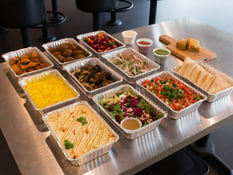After the terrible, horrible, no-good, very bad year that was 2020, some hope is peeking over the horizon for the food and beverage industry. A year after various states began instituting lockdowns to fight the pandemic, things are looking up (finally, a little bit at least!) for restaurants and bars. And none too soon, given that 110,000 restaurants closed in 2020 as people avoided indoor dining and revenues plunged. The pandemic put millions of restaurant workers out of a job. Now many of them are looking to get back in the game.
The question facing restaurant operators now, though, is how to return to normal. Any recovery is fragile for the time being, and the uncertainty around health, safety, and money is only going to raise the stakes for the perennial questions: Who should we hire? How do we know we’re making the right choice? For restaurants looking for affordable hourly workers, restaurant hiring software may be part of the answer. Because this year also asks, How do we do all of that as a worldwide pandemic thaws?
“We don't know if that mass rehiring is going to occur in three months, six months, or nine months,” says AJ Richichi, the founder of a restaurant hiring software company called Sprockets. “But there's going to be a day here in 2021, where people start coming out again, people with cabin fever start eating in, and we have this huge push to the restaurant scene. A lot of restaurants aren't staffed for that right now. Over probably a 90-day period, there's going to be more hires made in hospitality history than ever before.”
>>>RELATED: How To Staff A Restaurant Right: Positions, Training, Scheduling & More
The race for the best restaurant hiring software
Even before the pandemic, companies like Richichi’s were racing to have the best restaurant hiring software. The restaurant industry was expected to be worth almost $900 billion in 2020 before the pandemic hit, by the National Restaurant Association’s projections. Yet the nature and culture of working in restaurants has always been a peculiar one. Restaurants tends to hire lots of young workers, workers without much formal education, and workers who don’t intend to make a career out of a stint in a particular workplace. This is where an affordable hiring software can make a difference.
If you’ve ever worked in a kitchen, you know there’s a certain culture among colleagues that makes the workday feel like more than punching a clock. Yet that camaraderie doesn’t always translate to loyalty to a particular restaurant or company. Finding reliable employees can be tricky. Keeping them, even trickier. And when you lose them, the time and expense it takes to find, hire, and train a replacement could cost you thousands of dollars.
Naturally there’s a ton of upside for any restaurant tech company that can figure out how to help you identify, hire, and retain workers who will be a fit for your business. Here are some of the leaders in the field, worth a look if you’re scrambling to figure out how to put your share of that federal $25 billion restaurant bailout toward staffing up, now that times are looking up again and you may be reopening your restaurant during the pandemic.
>>RELATED: A Guide to the Latest Restaurant Technology Changing the Industry
Why a pre-screening software can be invaluable
Once you’ve identified your candidates, you want to make sure they’re a fit for your team — temperamentally, culturally, whatever you want to call it. And maybe you’re the world’s most insightful interview, and if so, Peter Falk will probably play the lead in your biopic.
Other people turn to tools rooted in behavioral assessments. Traitset, a human resources software company with a focus in the hospitality industry, offers pre-screening assessments through which you can measure potential hires on their work ethic, their customer service, or their leadership.
“It's very effective,” says Dan Longton, TraitSet's CEO and co-founder. “Our assessments are very accurate, and more importantly, they predict behavior to the point of it being reflected in performance appraisals.” Folks who did better on the assessment before being hired, in other words, turn out a year later to be better employees.
Those pre-screening traits go beyond simply the usual compatibility for being a good worker. Kitchens in particular are unique environments in which you want to be sure people are chill under pressure. Even if you settle on hiring someone you’re less than thrilled about, you know where the trouble spots are likely to arise. The company, which touts Burger King and Buffalo Wild Wings among its clients, claims that its tools and methods can cut employee turnover by half.
“If you got someone in the kitchen working with knives, maybe you want to look at antagonistic behavior,” says Dave Anstett, TraitSet’s vice president of sales and marketing. “We don't tell people who to hire. We score them — and they might score high or low. Employers can hire anybody they want, but then they'll at least have a profile.”
Restaurant hiring software can cut down on turnover
Preventing turnover is also part of the mission at Sprockets, which uses artificial intelligence to predict whether an employee will be a cultural fit at a restaurant, and which counts among its clients the likes of Five Guys and Chick-fil-A.
Once Sprockets surveys your existing employees to build a baseline of who fits your company culture — “the aggregate mental makeup, and needs, values and personality traits of your top-performing people,” in the words of Richichi. Then Sprockets builds a model and offers new applicants a short writing exercise that Sprockets then crunches and compares to the successful baseline.
The company also offers tools that help hiring managers screen out their own unconscious biases and keeps restaurants compliant with Department of Labor guidelines on what can and cannot be asked during an interview — questions that might be construed as fishing for someone’s age, for instance.
“Oftentimes in restaurants we fall victim to the assumption that anyone with a warm body can come in and work here,” Richichi says. “Well, that's a really challenging thought process, just because all of your customers are interfacing with almost all of your employees. Whether you make one bad hire, or 10, or 100, over the course of the year, it can negatively impact your company. Deploying any screening tool, in my opinion, is just invaluable.”
The best restaurant hiring softwares also do staffing
But truth is, sometimes as a restaurant owner you simply need some bodies in place, quickly. Temping agencies might not be optimal; they take a large cut of your available budget for a given shift, and might not lead to a longer relationship with a great worker.
The platform SnapShyft aims to overcome that by creating what it calls “a labor marketplace” where pre-vetted restaurant workers are available for on-call work as you need them, perfect for workers who want to do gig work. The Indianapolis-based company does the background check and handles pre-screening. It boots people who flake out on a shift, creating two-way accountability along the way. The workers get a stable relationship with a platform that pays them and offers them benefits, while restaurant owners get to fill out a work order in just two minutes via a mobile app.
“Resumes lie,” says Thor Wood, the founder and CEO of SnapShyft. “They don't tell even a tenth of a story of where you've been, potentially. We only allow people that have actual verifiable industry experience to use the platform, so you're not getting temps. You're getting, potentially, your competitor’s chef who has a night off or needs some extra cash for the holidays who’s willing to wash your dishes.”
TraitSet also makes it easy for restaurants to leverage their existing staffers’ networks to put out the word on social media when there’s an immediate opening. Think of it as a way to amplify the old-fashioned word-of-mouth that has always helped restaurants hire.
“Some of our customers go to their servers and say, ‘Hey, we need some more servers. Everybody pull up your Facebook page,’” Dave Ansett says. “These people have thousands of friends. If they share that — and it's for free — it gets blasted to the news feeds of these thousands of people, versus just posting it on your company Facebook page that no one sees unless they go there. That's a key, unique feature. We can do that by each location, so if someone has 300 locations, each location will have their own.”
[Photo by Tim Douglas from Pexels]




